Environmental sensors
Introduction
Environmental sensors detect and measure various parameters in the surroundings, typically temperature, humidity, noise levels, vibrations, or different types of pollution.
An air quality sensor is a type of environmental sensor that specifically detects and measures air quality parameters such as gas and particle content. Such sensors are often designed for use in environments with generally good air quality where you want to be notified about anomalies.
This white paper presents an overview of network-connected air quality sensors, what they measure, and how they work.
Background
Maintaining a healthy and sustainable indoor environment is important for a number of reasons, including HSE (health, safety, environment), operational efficiency, and business intelligence. By measuring various indoor air quality parameters, detecting anomalies, and adjusting accordingly, you can ensure a healthy and comfortable space for occupants.
Monitoring temperature and relative humidity levels also plays a significant role in maintaining an indoor environment that supports equipment longevity while allowing you to make adjustments as needed. The data can be used to inform decisions on ventilation and other aspects of building management, ultimately contributing to a more sustainable and efficient operation.
Furthermore, the possibility to document and prove adequate management of indoor air quality could help you reach sustainability goals or demonstrate compliance with relevant regulations. Advanced sensors can detect vaping and smoking, enabling you to take swift action to keep a smoke-free environment.
What to measure and why
Important air pollutants to monitor include particulate matter (PM), volatile organic compounds (VOC), nitrogen oxides (NOx), carbon dioxide (CO2), as well as vaping and smoking. You might also want to measure the relative humidity (RH) and temperature of the air. In addition, you can determine the air quality index (AQI) over time.
Particulate matter. Exposure to particles can cause short-term health effects, such as eye, nose, and throat irritation, coughing, and shortness of breath. It can also affect lung function and worsen medical conditions such as asthma and heart disease. Examples of particulate matter include pollen, mold, spores, dust, and smoke, as well as aerosols emitted by vapes. Particulate matter is typically categorized by diameter:
PM1. Ultrafine particles, smaller than 1 micrometer in diameter. Can penetrate deep into lungs and bloodstream.
PM2.5. Fine particles, smaller than 2.5 micrometers in diameter. Commonly associated with air pollution and respiratory issues.
PM4. Coarse particles, smaller than 4 micrometers in diameter. Often linked to dust, pollen, and other larger airborne pollutants.
PM10. Inhalable particles, smaller than 10 micrometers in diameter. Includes both fine and coarse particles that can enter the lungs.
VOC. Several VOC are dangerous to human health or cause harm to the environment, and some are regulated by law. Most VOC are not acutely toxic but can have long-term health effects. VOC can be emitted from products such as paints, solvents, disinfectants, moth repellants, and stored fuels and automotive products.
NOx. Nitrogen oxides in indoor air environments are the most relevant pollutants of the oxidizing gases. Any long-term exposure, even at small concentrations, can be considered harmful. Nitrogen oxides are produced during combustion processes, typically in car engines or through cooking on a gas-powered stove, burning candles, or smoking. Outdoor sources, such as car exhausts, can affect indoor air quality in a building if the building’s air filtration system is inadequate.
CO2. High concentrations of carbon dioxide can cause headaches and breathing difficulties. In schools and offices it can decrease learning and productivity by reducing students' and employees' ability to focus. Because humans exhale carbon dioxide, its concentration normally rises in poorly ventilated indoor spaces. Carbon dioxide also comes from the extraction and burning of fossil fuels. Carbon dioxide (CO2) should not be confused with carbon monoxide (CO).
Vaping and smoking. Vapes generate fine particles that spread and settle throughout the airways. Smoking is linked to numerous negative health effects, such as respiratory problems, chronic bronchitis, heart disease, and lung cancer.
Relative humidity. Too high humidity levels can cause mold growth in a building while too low levels cause human skin and eye irritation and dryness. Controlling humidity levels is also important in server rooms and data centers to extend the lifespan of sensitive equipment. Indoor humidity levels are typically affected by ventilation, cooking, and air conditioning.
Temperature. Too high or too low temperatures can have negative impact on both human comfort and equipment longevity. Indoor temperatures are affected by outside temperatures in combination with inadequate insulation or inadequate heating. Appliances or machines can also generate a lot of heat indoors.
AQI. The air quality index is a widely used metric that quantifies the level of airborne pollutants. By measuring concentrations of fine particulate matter (PM2.5) over a 12-hour period, the AQI categorizes air quality into distinct categories. The NowCast method uses a weighted average of the past 12 hourly measurements to provide an AQI estimate in real time.
Measurement technologies
Axis air quality sensors use the following technologies for measuring the levels of the air quality parameters.
Optical particle counters (OPC) are used to measure particulate matter. An OPC works by shining a laser at the air that passes through the sensor. The flow of air is controlled by a fan. As light from the laser is scattered on the particles in the airflow an optical sensor measures the amount of scattered light. From this, the OPC can calculate the amount and density of the particles. It can distinguish between different particle compositions and identify, for example, aerosols emitted by vapes.
Metal oxide (MOX) sensors are used to measure VOC and NOx. A MOX sensor reacts to the amount of oxygen around the sensor. NOx gases are oxidizing (increasing oxygen) while VOC are reducing (decreasing oxygen) as they combust on the surface of the MOX sensor. Humidity will also decrease the amount of oxygen. This means that having both NOx gases and VOC in the air simultaneously will cause the gases to counteract each other. All these factors are compensated for by using the integrated humidity sensor and enhancing selectivity to specifically measure reducing gases or oxidizing gases.
Pulsed IR light sources are used to measure CO2 levels. The light sources emit wavelengths that are absorbed by CO2. Because the light source is pulsed, the CO2 molecules that it hits start to vibrate and create an acoustic wave. The more CO2 molecules present, the louder the acoustic wave. This is measured by a microphone to calculate CO2 concentration.
Sensor placement and coverage
You should place the sensor as close as possible to your area of interest to get optimal readings. Choose a location that allows free airflow, away from corners and heat sources and not too close to windows or air vents. This way you minimize the impact of airflow patterns and heat on the sensor's accuracy.
Optimal placement also depends on which measurements you want to prioritize, so check the product’s user manual for installation guidelines specific to your use case.
For effective monitoring of air quality you should typically install the sensor on the wall. Placement at a height of 0.9–1.8 meters (3.0–5.9 feet) from the floor makes sure that the sensor measures air quality at breathing level and provides accurate readings relevant to human exposure. In large spaces you might need multiple sensors to maintain accurate detection and proper coverage.
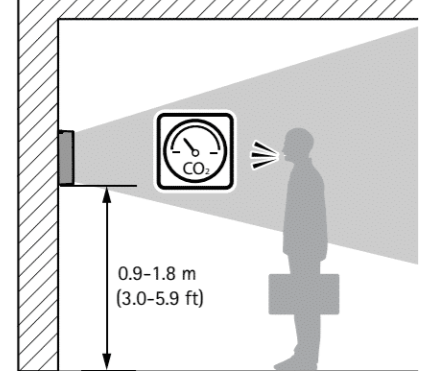
For detection of vaping or smoking you should typically install the sensor in the ceiling. A ceiling-mounted air quality sensor from Axis covers approximately 12 m2 (130 ft2), with a detection radius of 2 meters (6.5 ft) from the point directly below the sensor.
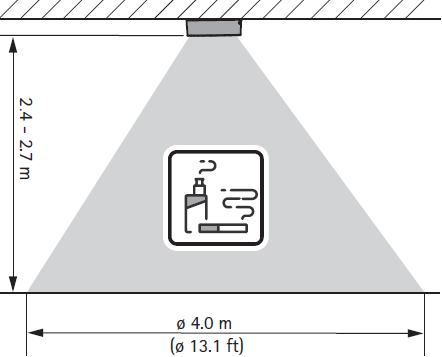
Use cases
Air quality sensors can be used to support HSE (health, safety, environment), improve operational efficiency, and provide business intelligence.
Detect vaping and smoking. Detecting vaping and smoking and initiating an appropriate response provides the opportunity to intervene when smoking prohibitions are not followed. Automated or manual responses can include sending an audio or visual alert, starting a video recording, or informing personnel.
Ensure healthy indoor air quality. By monitoring indoor air quality, you can stay ahead of emerging concerns and detect anomalies that may go unnoticed by occupants. Air quality sensors can keep track of key indicators, such as CO2 levels, and trigger alerts and events when readings exceed your set limits. The alerts can trigger automated or manual responses, such as informing staff and occupants of insufficient air quality or adjusting ventilation to restore optimal air quality.
Attain a good indoor environment. By monitoring temperature and relative humidity, you can detect anomalies and adjust accordingly to prolong machine health and equipment longevity. An air quality sensor can trigger alerts when it detects levels outside your preset range so you’ll know when you need to adjust ventilation.
Analyze historic data and metadata for informed decisions. Sensors can help you gain an understanding of how your indoor air quality varies. They provide the metadata you need to be able to analyze the trends over time and make decisions on, for example, ventilation and how to design your space.
Achieve sustainability goals. By installing air quality sensors, you can gather data to help you follow up on sustainability goals and communicate your efforts.
Comply with regulations. By installing air quality sensors you can document and prove adequate management of indoor air quality.
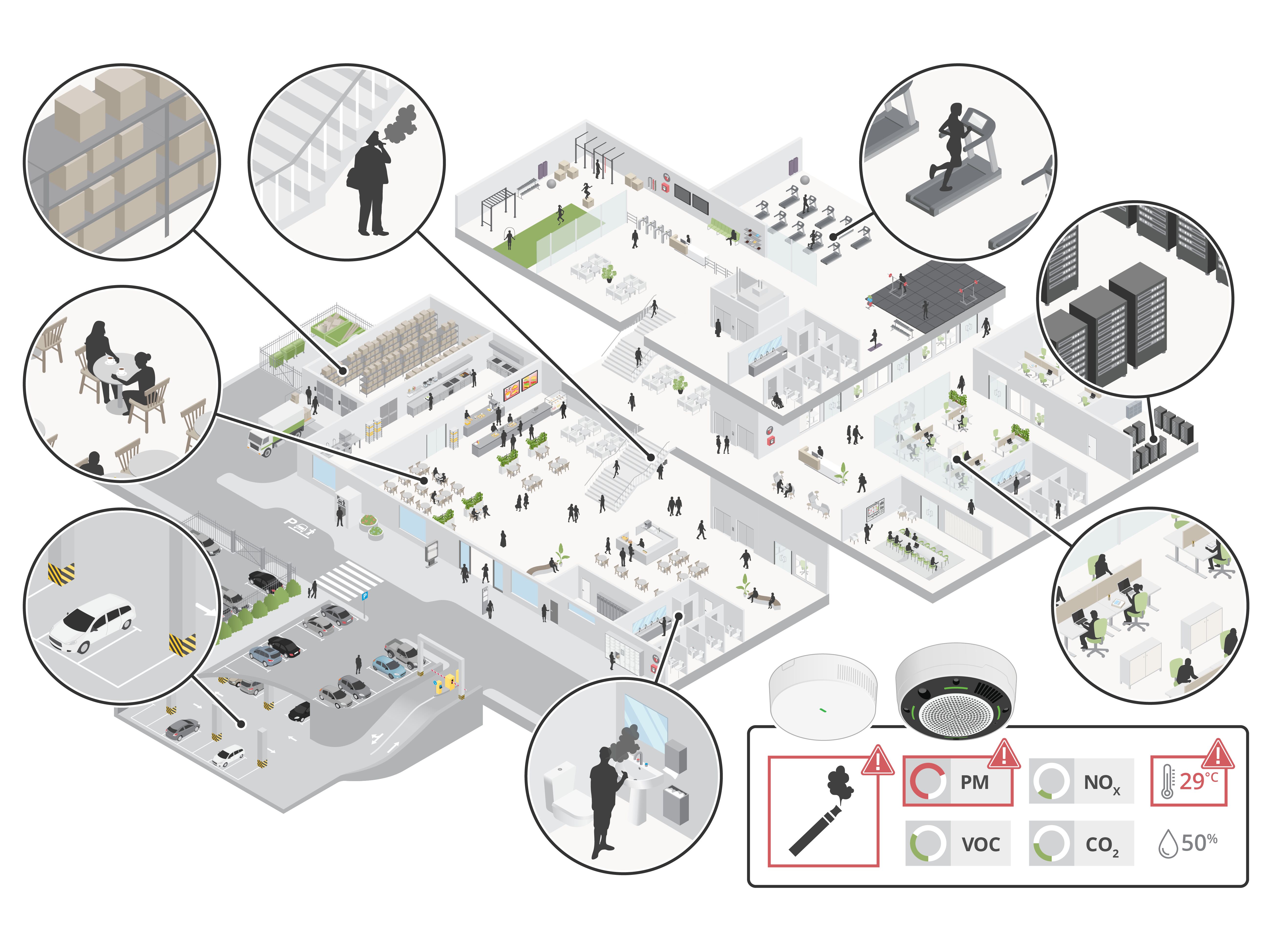
Use in industry segments
Air quality sensors can play a vital role to prevent health risks, improve productivity, and optimize operations across multiple sectors.
Education. Promoting a healthier environment in schools is crucial for the well-being and success of students, as it helps prevent focus issues and other problems caused by poor air quality. By preventing vaping and smoking in common areas such as restrooms, hallways, classrooms, libraries, cafeterias, auditoriums, and recreational areas, educators can help create a safer and more supportive learning atmosphere.
Data centers. Regulating temperature, humidity, and particulate matter levels can help extend the lifespan of equipment.
Commercial real estate. Monitoring air quality enables smarter building management in office buildings, hotels, or public areas. Indoor air quality is also a component in green building certification systems, which assess the environmental sustainability of buildings.
Critical infrastructure/Industrial. Controlling air pollution, sometimes caused by the industrial process itself, safeguards worker health and product quality in industrial settings. Examples include food processing factories, areas with debris and burning of materials, and areas where chemicals are processed.
Retail. Maintaining good air quality enhances the customer experience in shopping malls and stores. Conversely, poor air quality can lead to discomfort and health issues, while good air quality encourages longer shopping trips.
Healthcare. Clean air is crucial in operating rooms, patient areas, and ICUs. Close monitoring of air quality can also be critical during renovations or construction work in hospitals and care facilities.
Air quality sensors from Axis
Axis offers two types of air quality sensors. One is a standalone IP network device and the other must be connected to a host IP network device.
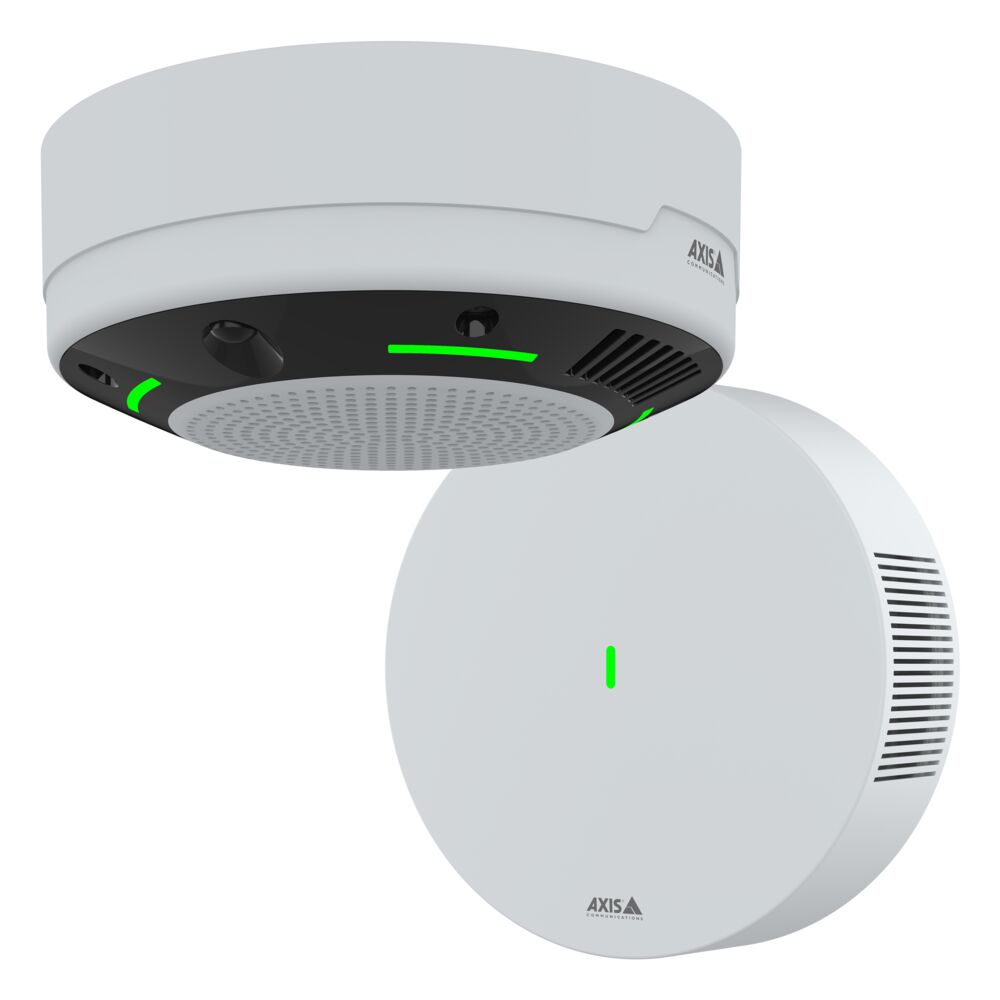
Axis air quality sensors measure indoor air quality parameters and detect vaping and smoking. You can set them up to trigger automatic events to notify you when parameter values reach above your set thresholds.
| Parameter | Measurement range |
|---|---|
| Particulate matter (PM) | PM concentrations between 0 and 1000 μg/m3 for particle sizes between 0.3 µm and 10 µm. Separate measurements for each size category, PM1, PM2.5, PM4, and PM10. |
| Volatile organic compounds (VOC) index | 0 to 500 *, collective VOC presence <100: lower than the average of last 30 days >100: higher than the average of last 30 days =100: no change compared to average of last 30 days |
| Nitrogen oxides (NOx) index | 0 to 500 * <1: lower than the average of last 24 hours >1: higher than the average of last 24 hours =1: no change compared to average of last 24 hours |
| Carbon dioxide (CO2) | 0 to 40,000 ppm * |
| Air quality index (AQI) | 0 to 500 * |
| Relative humidity (RH) | 0 to 100% (non-condensing) |
| Temperature | -10 °C to 45 °C (14 °F to 113 °F) |
| Vaping and smoking | Detected or undetected |
* See applicable calibration periods.
The VOC and NOx parameters are measured as indexes instead of absolute values. This is a choice we’ve made in order to be able to provide a low-maintenance air quality sensor. The type of sensor that measures absolute VOC and NOx values would require regular manual recalibration with VOC and NOx solutions of known concentrations.
For VOC, the index baseline value is 100. Values below 100 indicate that the concentration of VOC in the air is lower than the average of the last 30 days. Values above 100 indicate that the concentration of VOC in the air is higher than the average of the last 30 days. If the value is 100, the concentration of VOC in the air is the same as the average of the last 30 days. It should also be noted that the VOC index value is affected by the collective presence of VOC, rather than by each compound individually. If the VOC index gets higher than expected, you might want to conduct additional analysis to identify the primary contributor.
For NOx, the index baseline value is 1. Values below 1 indicate that the concentration of NOx in the air is lower than the average of the last 24 hours. Values above 1 indicate that the concentration of NOx in the air is higher than the average of the last 24 hours. If the value is 1, the concentration of NOx in the air is the same as the average of the last 24 hours.
Due to automatic calibration, the measurements of AQI, CO2, VOC, and NOx take time to be functional.
Full CO2 accuracy takes 2 days the first time the device runs.
The AQI requires 12 hours to be functional the first time the device runs. The AQI will show ”Calculating” until it has enough data. The calibration time is required every time the device reboots.
Full VOC accuracy is obtained after the device has been running for one hour. The calibration time is required every time the device reboots.
Full NOx accuracy is obtained after the device has been running for 6 hours. The calibration time is required every time the device reboots.
For more guidance on how to interpret your measurement results in terms of air quality, see the relevant product’s user manual.
You can display the measurement results in a dashboard to view live data but also visualize historical data and trends over time.
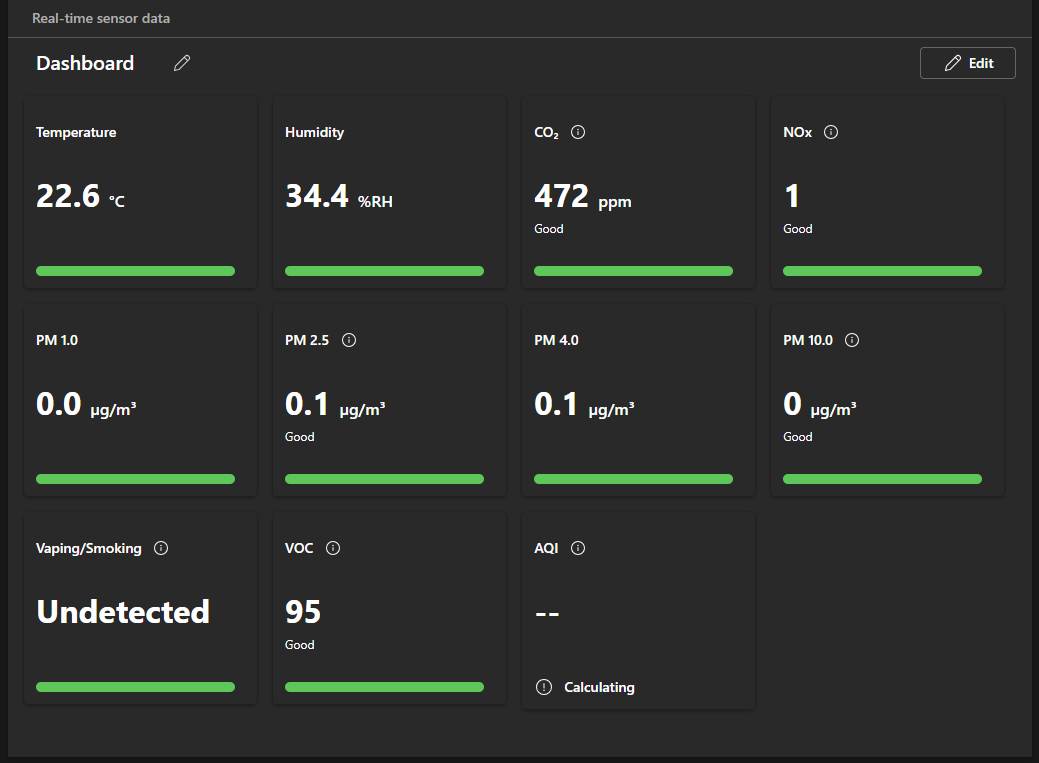
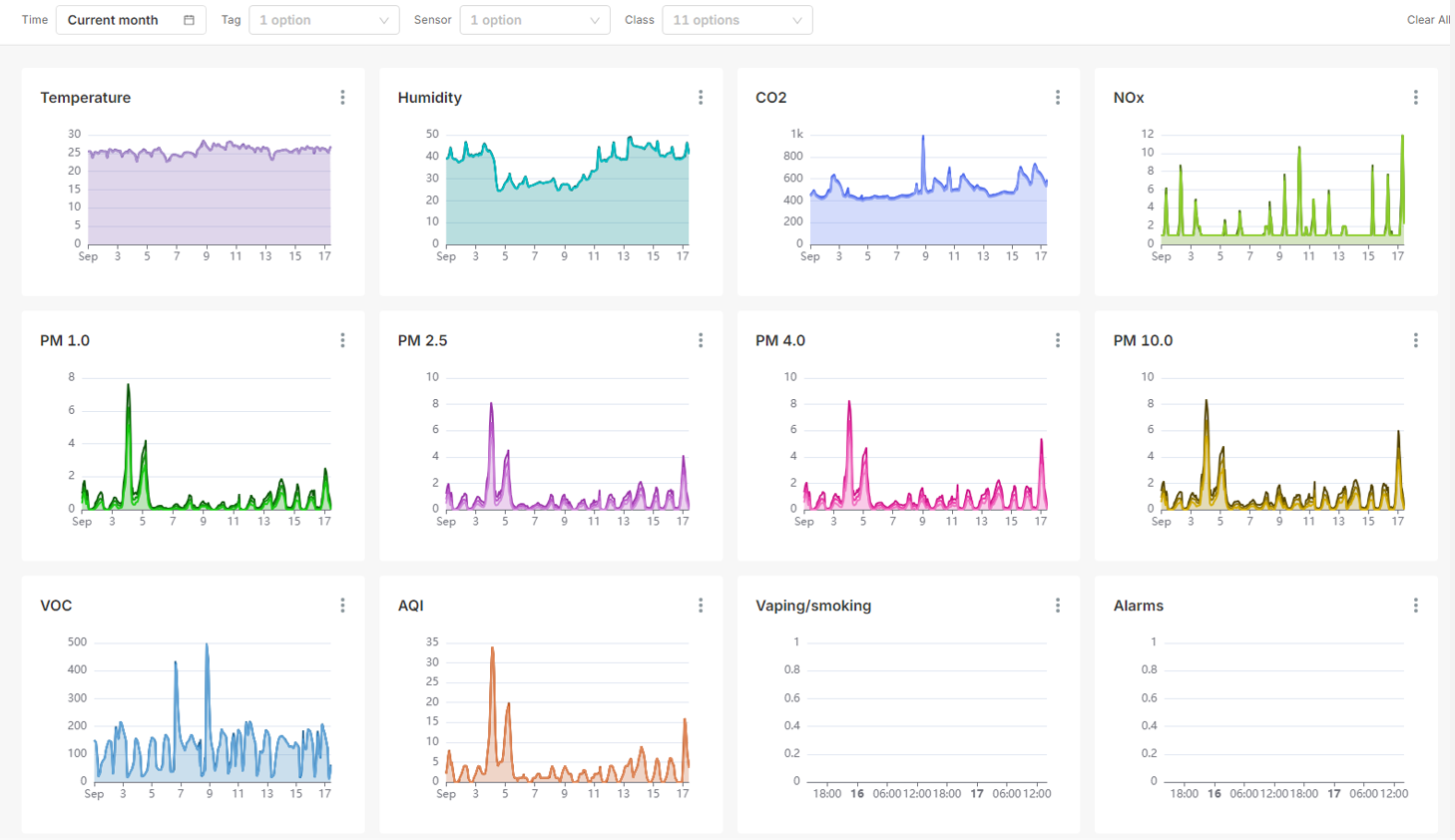
Standalone air quality sensor
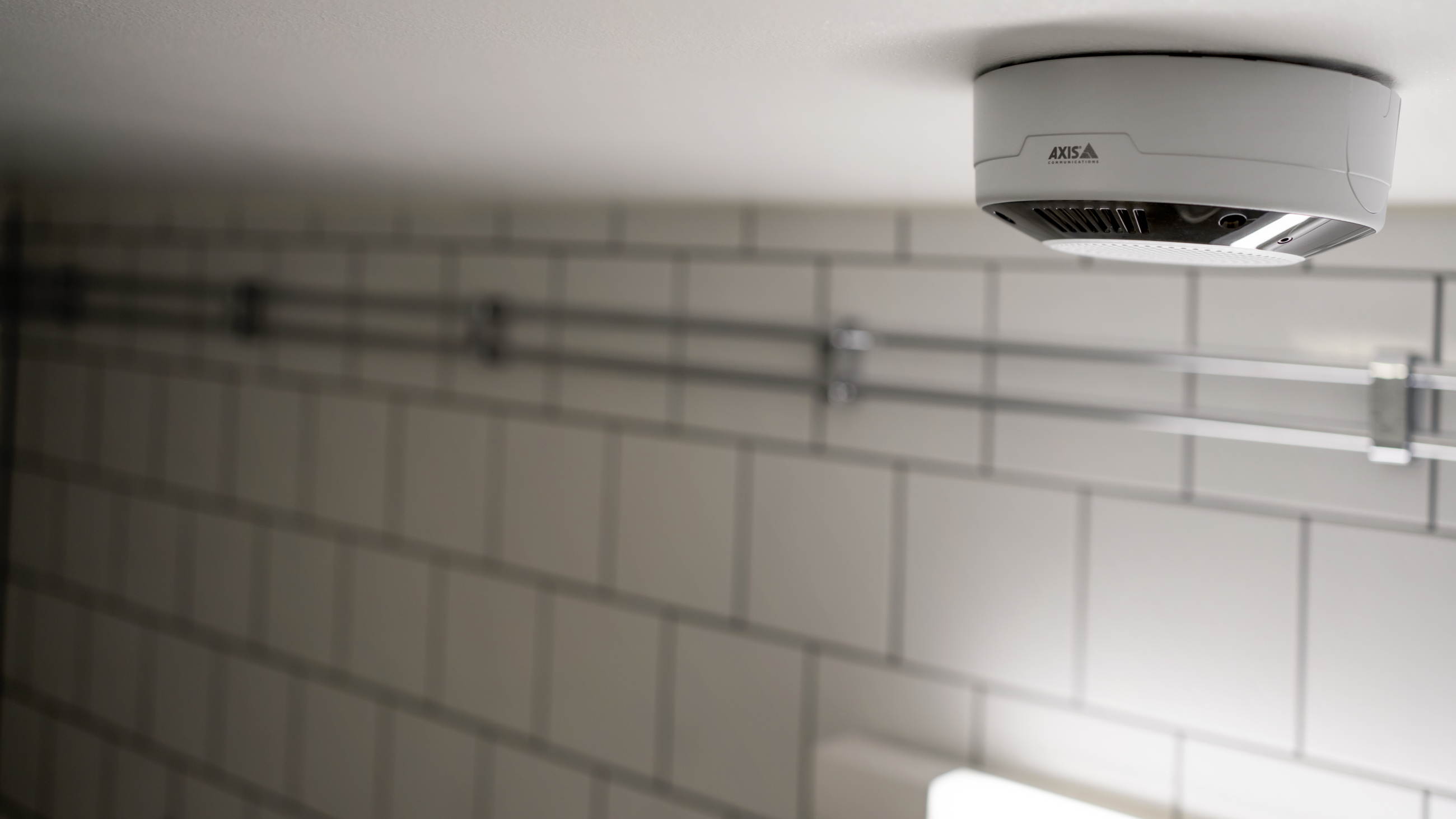
The standalone air quality sensor can detect vaping and smoking as well as the various air pollutants and parameters. Through its many additional capabilities, it also enables proactive management of air quality and efficient responses to issues. For example, it has a PIR sensor for presence detection and multicolor LEDs for visual alerting. The device also has two-way audio for both voice messages and audio analytics. Read more about AXIS Audio Analytics at whitepapers.axis.com/audio-analytics-for-security-and-safety.
With the standalone air quality sensor, measurement results are available in the sensor’s web interface and a dashboard stream also allows you to view measurement results in your VMS.
Air quality sensor with host device

Our portcast-based air quality sensor is a relatively cost-efficient product that requires a host device. Selected Axis devices can function as host device so you can easily add the sensor in your surveillance system.
The connection between the sensor and the Axis host device works through Axis portcast technology, which lets you seamlessly add functionality (in this case air quality measurement capability) to the host device. This means that the sensor uses the host device’s IP address and is controlled from the host device. Measurement results are available in the web interface of the host device and also in the camera stream through MQTT overlays.
